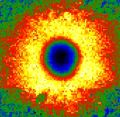Speakers
Description
The advancement of electronics in recent decades caused a sudden demand for new materials suitable for data processing. A notable focus has emerged in the field of optoelectronics, which utilizes light for processing information. This trend has heightened interest in materials capable of responding effectively to incoming light pulses.
Bismuth vanadate (BiVO4) nanoparticles were modified with heptazine (g-C3N4). These materials are intriguing and widely studied semiconductors in the context of photocatalysis and photoelectrochemical application. The research involved performing Scanning Electron Microscopy (SEM) characterization, investigating synaptic effects, conducting X-Ray Diffraction (XRD) characterization of the materials, determining band gap energy.
g-C3N4@ BiVO4 materials were synthesized using the sonochemical method, with sodium metavanadate and bismuth nitrate employed for bismuth vanadate synthesis. The solutions were mixed and then placed in an ultrasonic reactor for 90 minutes. During the synthesis of materials with the addition of heptazine, pure heptazine was added to the bismuth nitrate solution. Prior to mixing with the sodium metavanadate solution, it was sonicated in an ultrasonic bath for 30 minutes.

SEM images and XRD analysis confirm the homogeneous material with a unique shape. Additionally, the band gap of 2.37 eV presents an opportunity to absorb UV-Vis light. Here, we present research on materials obtained by modified semiconductor with heptazines, which shows the Photoelectrochemical Photocurrent Switching Effect (PEPS effect), thus opening up new avenues in the study of such structures .
Bibliography:
1 Lin Zhou, Wenzhong Wang , Shengwei Liu, Lisha Zhang, Haolan Xu, Wei Zhu - ,, A sonochemical route to visible-light-driven high-activity BiVO4 photocatalyst’’, https://doi.org/10.1016/j.molcata.2006.01.052
2 Gang-Juan Lee , Xin-Yu Lee , Cong Lyu , Na Liu , Sambandam Andandan, Jerry J. Wu - ,, Sonochemical Synthesis of Copper-doped BiVO4/g-C3N4 Nanocomposite Materials for Photocatalytic Degradation of Bisphenol A under Simulated Sunlight Irradiation’’,
https://doi.org/10.3390/nano10030498
Acknowledgments:
NCN grant: Light intensity controlled photoelectrochemical switches for pattern recognition (program: OPUS, UMO-UMO-2022/47/B/ST4/01420)

